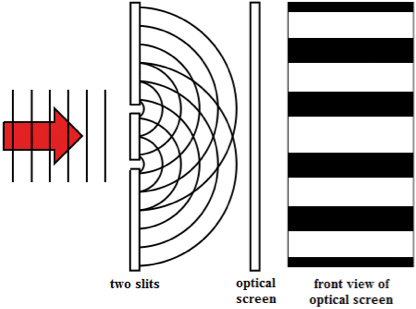 Source: Two-Slit Experiment light, Inductiveload, Wikimedia
Source: Two-Slit Experiment light, Inductiveload, Wikimedia
Light has properties of both particles and waves. Our early understanding of light was totally based on the wave model. Modeling light as a transverse wave explained reflection, refraction, image formation with mirrors and lenses, diffraction, and interference. As shown in lesson 4 of this module, all of these are behaviors of waves; and two of them—diffraction and interference—can only be explained using a wave model.
In the early 1800s a scientist named Thomas Young shined light through two very thin slits scratched into painted glass. Following the rules of diffraction, the light wave spread out behind each slit and the two spreading waves interfered with one another making an interesting pattern of alternating light and dark stripes on the wall.
 Source: Two-Slit Experiment light, Inductiveload, Wikimedia
Source: Two-Slit Experiment light, Inductiveload, Wikimedia
From his findings, Young concluded that light must be a wave.
Scientists were very comfortable with their understanding of light until the observations of two scientists noted behaviors that didn't fit in. In 1887, Heinrich Hertz noticed that electrodes created sparks more easily when exposed to high frequency light. It seemed that the light was knocking electrons free from the surface. Waves would not interact with electrons in this way. This is called the photoelectric effect, and will be discussed in detail in the next section. Later, in 1923 Arthur Holly Compton observed high energy gamma rays interacting with electrons in a way that looked like inelastic collisions. If light were a wave, there would be no energy loss, and no recoil from the collision. From his observations, Compton concluded that light must be a particle.
The argument went on for a long time. On the one hand, light diffracts and interferes, so it must be a wave. On the other hand, the observations of Hertz and Compton suggest it must be a particle.
Einstein was once asked by one of his students, "Professor? Is light a wave or a particle?"